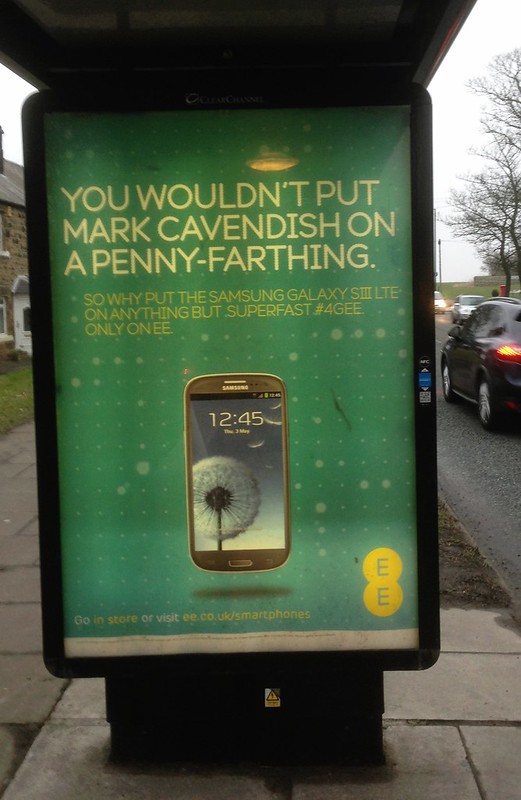“You wouldn’t put Mark Cavendish on a penny-farthing…”
EE is trying to sell folks its 4G service by using fast athletes on slow modes of transport. “You wouldn’t put Steve Redgrave on a pedalo” is one of the treatments, the other is this take on “penny-farthings” (purists prefer the terms ‘ordinary’ or high-wheel bicycle). Thing is, ordinaries were the red Ferraris of their day, the fastest vehicles on the roads.
 When high-wheel bicycles are seen at fêtes, or on telly, or on posters for TfL competitions, it’s ten to a penny (farthing) that the gents riding them will be prim, proper and of relatively advanced age. Top hat. Waistcoat. Long jacket and cravat. Waxed mustache. Respectable. Slow. Staid.
When high-wheel bicycles are seen at fêtes, or on telly, or on posters for TfL competitions, it’s ten to a penny (farthing) that the gents riding them will be prim, proper and of relatively advanced age. Top hat. Waistcoat. Long jacket and cravat. Waxed mustache. Respectable. Slow. Staid.
This Victoriana visual is dead wrong. Direct drive bicycles of c.1877 through to the late 1880s had developed bigger and bigger front wheels not for comfort on bad roads but to make the bicycle go faster.
High-wheelers were hard to ride, dangerous, expensive, lightweight, technologically-advanced, and fast, very fast. They appealed to wealthy young men with time on their hands and who craved the speed and excitement of such machines. No doubt Mark Cavendish could whip up quite a sprint on a high-wheel bicycle. There were some diminutive high-wheel champions although it must be admitted most of the faster riders were gentlemen with long legs. The longer the lever the better.

Slow? Ordinaries were definitely not slow, as the book cover below attests. Yes, it’s an exaggeration but it shows a high-wheeler outpacing a train, and an equestrian (and, er, running over a bunny, too – or, as @MinistryofBikes suggests, it’s probably a hare that has collapsed after trying to race the cyclist):




2 thoughts on ““You wouldn’t put Mark Cavendish on a penny-farthing…””